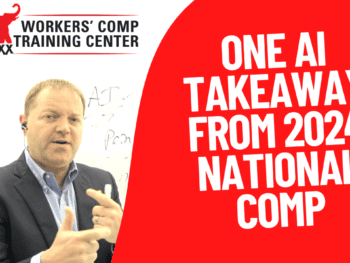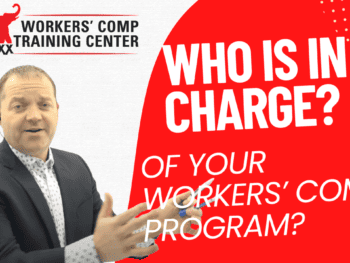Hello. Michael Stack here, principle of AMAXX, founder of Comp Club, and coauthor or ‘Your Ultimate Guide to Mastering Workers’ Comp Costs.’
Now there’s no mystery in how to reduce workers’ comp costs. That code was cracked over twenty-five years ago, and the system has been implemented in hundreds of organizations throughout that time frame, consistently achieving a 20%, and oftentimes greater than 50% reduction in workers’ compensation costs. That proven five-step system has been documented in detail in the 2016 version of ‘Your Ultimate Guide to Mastering Workers’ Comp Costs.’ I want to give you an overview of each of the five steps to hopefully set you on a path to reducing your work comp costs by 20%, and hopefully greater than 50%.
Step 1: Build Your Program Foundation
The first step then is to build your program foundation. Now if you’ve ever built a home or you’ve ever purchased a home, you know that the most important piece of that house is the foundation itself. If that foundation isn’t done well, it can put into question the integrity of the entire structure. The same is true in your work comp management program. You need to build a solid foundation on which to build the rest of your program. Now in step number one this includes things like getting your management onboard, gaining management commitment, and understanding the roles and responsibilities of all the different parties within your company. This also includes understanding key pieces of workers’ compensation information: things like your experience mod, the experience mod formula, and the different levers that go into that, including your payroll, and properly classifying your employees, as well as the insurance structure itself. Step number one is building a solid foundation on which to build the rest of your program.
Step 2: Injury Prevention
Step number two then is injury prevention. The least expensive work comp claim is the work comp claim that never happens. Injury prevention includes safety and wellness. Safety needs to be equal in priority to quality and production at your company; a hugely important piece to prevent claims from ever occurring in the first place. Studies show from a wellness standpoint that each dollar invested in wellness has a three to four dollar return on investment. Step number two is injury prevention. The least expensive work comp claim is the work comp claim that never happens.
Step 3: Post-Injury Systems
Step number three is post injury systems. This is the bread and butter at the employer site of your work comp management program. It’s the engine that’s going to drive success, the engine that’s going to drive the outcomes that are going to reduce your work comp costs and improve the environment for your injured workers. This includes things like communication systems, your post injury response procedures, your return to work procedure, as well as your reporting claims timely. All these post injury systems at the employer site are the engine that’s going to drive everything post injury.
Step 4: Claims Management Best Practices
If step number three is the engine, step number four is pouring a higher level of octane gasoline into that engine to further improve outcomes and further reduce workers’ compensation costs. Claims management is step number four and it’s all about leveraging the service provider relationships. This includes your adjuster, as well as detailing your account handling instructions, as well as when to use various vendors, things like an IME, when you’re going to use surveillance to help prevent fraud, as well as planning and preparing for settlements, including Medicare set-asides and structured settlements. Step number four puts a higher level of octane gas into the employer management systems.
Step 5: Control Medical and Pharmacy Costs
Step number five then is medical and pharmacy. The highest growing, and the fastest growing piece of workers’ compensation costs is in step number five, the medical and pharmacy components. NCCI projects that by 2017 over 70% of workers’ compensation costs will be driven by this step number five, and the medical and pharmacy components. This includes things like building out your medical provider relationships, leveraging a medical advisor, as well as using nurse case management. From a pharmacy standpoint, we know that the pharmacy and overdose of prescription drugs is the number one killer in the United States. It passed car accidents a number of years ago. From a safety standpoint, and a cost management standpoint, how to leverage that pharmacy benefits management relationship.
That is the proven five-step system, a very quick outline of how to achieve results. One tip is to follow these steps in sequence. Each step is going to build upon each other, and the better you do in the previous step the better your outcomes will be in the following steps. Start in sequence, identify your gaps, and you will achieve workers’ compensation success.
Again, I’m Michael Stack, coauthor or ‘Your Ultimate Guide to Mastering Workers’ Comp Costs.’ For further details on how to purchase the 2016 edition, go to http://wcmanual.com.
Author Michael Stack, Principal, COMPClub, Amaxx LLC. He is an expert in workers compensation cost containment systems and helps employers reduce their work comp costs by 20% to 50%. He works as a consultant to large and mid-market clients, is co-author of Your Ultimate Guide To Mastering Workers Comp Costs, a comprehensive step-by-step manual of cost containment strategies based on hands-on field experience, and is founder of COMPClub, an exclusive member training program on workers compensation cost containment best practices. Through these platforms he is in the trenches on a working together with clients to implement and define best practices, which allows him to continuously be at the forefront of innovation and thought leadership in workers’ compensation cost containment. Contact: mstack@reduceyourworkerscomp.com.
©2016 Amaxx LLC. All rights reserved under International Copyright Law.
Do not use this information without independent verification. All state laws vary. You should consult with your insurance broker, attorney, or qualified professional.














